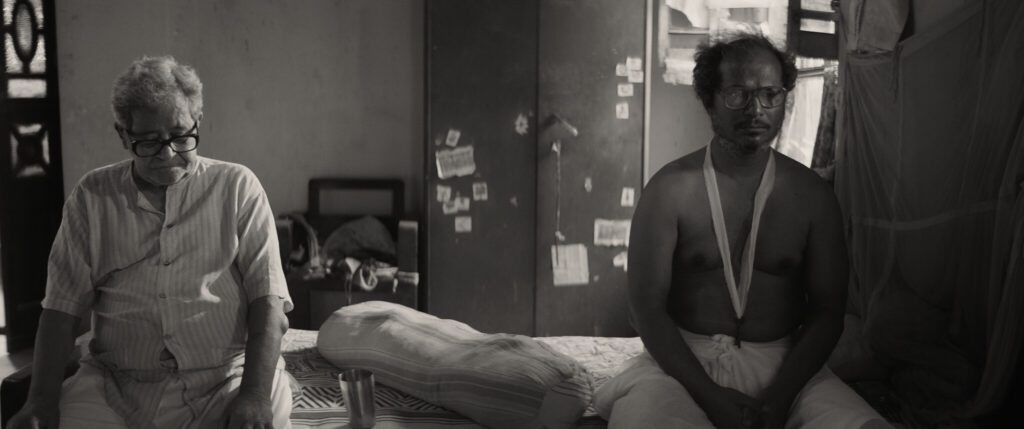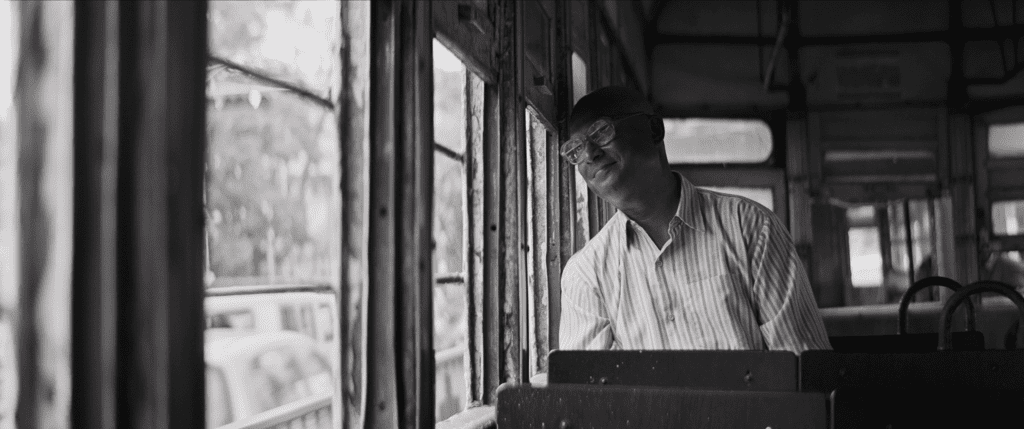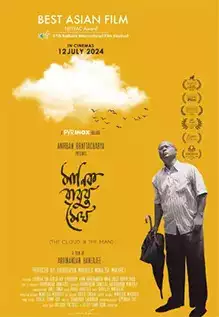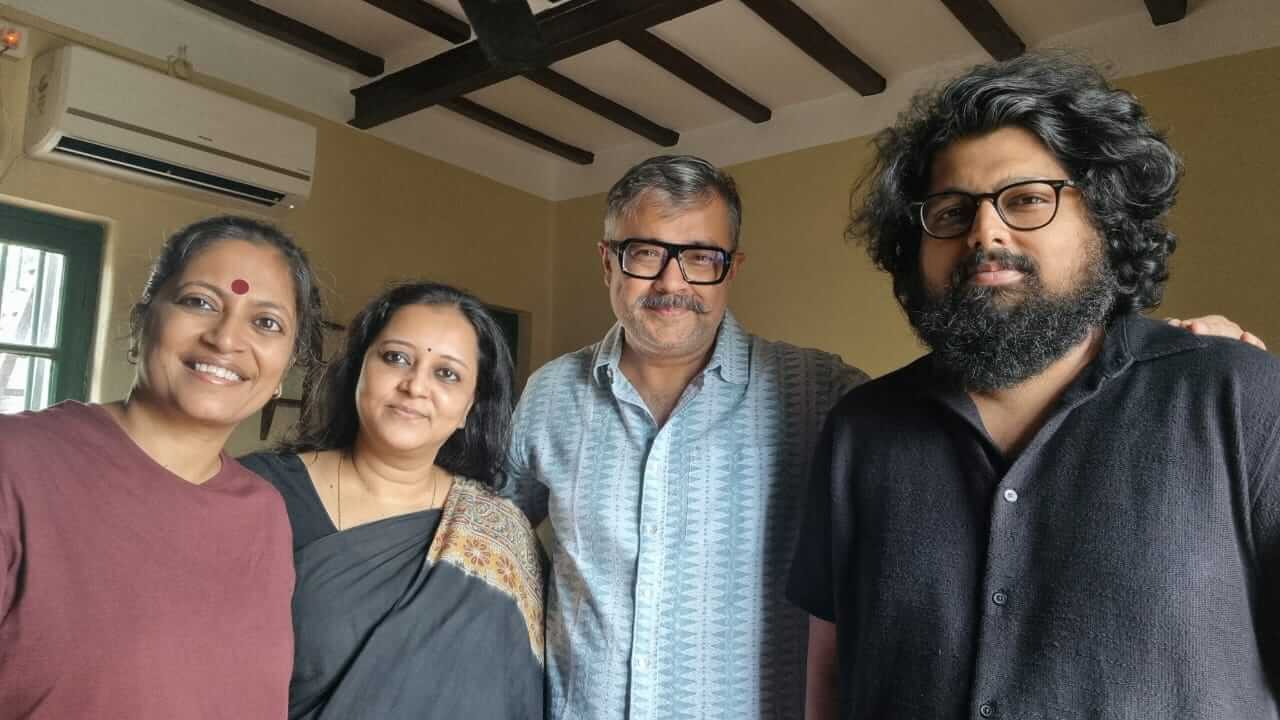Reading Time: 10 minutes
Manikbabur Megh, a Bengali film, gained cultural traction in an exclusive interview with Gopa for Different Truths, discussing themes, characters, language, and production challenges.
It was almost the beginning of June. Kolkata’s first strong showers had refreshed the polluted city in all its glory. People were leaving OTT platforms and hitting the cinemas all over India to watch a Bengali film named Manikbabur Megh—the Cloud & the Man. Directed by Abhinandan Banerjee and produced by Founder Directors of Little Lamb Films, Monalisa Mukherji and Bauddhayan Mukherji. Nandan had houseful shows for two weeks at a stretch, cinema lovers were all in awe, and critics had nothing negative to say. The theatre and movie artists were mesmerized. In fact, after watching the film, the audience came out in a state of rejuvenation. The 97-minute movie became the talk of the town.
I was invited to Bauddhayan Mukherji’s ancestral home for an exclusive discussion with the core team members, without whom Manikbabu would have never fallen in love with the cloud.
Gopa: Though fictitious, films such as Manikbabur Megh seem to be an inspiration from some real-life story. Is there any background story related to this film?
Abhinandan: I read a quote by Jordan Peele that every creation of a creator carries a little bit of himself or herself. Manikbabur Megh is no exception. People who know me have often said that Manikbabu is me. It is a simple fantastical story—a socially unfit man living in a society where the harbinger cloud comes as a liberator of love. For a person who is a nature lover, his emancipation
only comes from nature. That explains the presence of the cloud in the film. For me, clouds are the strongest epitome of nature. Clouds have life, they breathe, they keep changing colour; they have movement in them, and they have a lifelike beauty. The story is all about the relationship that develops between the fantasy cloud and Manikbabu.
Monalisa: It all started in Santiniketan, where Abhinandan first narrated the germ of the story. I resonated with it. I just loved the idea and thought that it had to be made. I am generally a very anti-violence, anti-gore person. I love things tender. On hearing Abhinandan’s idea, I thought people must know about this uniquely tender story of love. I am so happy that we have made it. I feel stories and life are not just about violence and bloodshed. A caring love story is important in our lives.
Gopa: Manikbabur Megh seems to be quite different from the other films of the auteur category. What distinct treatment did you extend for this one?
Abhinandan: A film that is made out of pure cinematic language has four strong pillars: the images, the sound, the music, and the dialogue. The first two are of immense significance to me. I try to weave my narrative through images and sound. Music and the dialogues come later. I have never really thought of making a film that can be categorized as an amateur movie. Simplicity has always been the key for me. What I wanted to create is a simple story about a simple man and not make the narrative allegorically
difficult. Hence Manikbabur Megh is as simple as Manikbabu himself. Additionally, the sole motivation behind the character Manikbabu’s actions is the cinematic language—he is quiet and does not speak much, but there are a lot of sounds all around him. Not necessarily words. As a filmmaker, my task was to follow the journey of this man and that gave me the direction of what the treatment and language of the cinema would be.
Monalisa: When we decided that we were going ahead with this story, our prime focus was to create Manikbabu’s space as real as possible. In my years in cinema, I have learnt how to create a character and his/her space by keeping the psychographics and demographics in mind. And that can be achieved in a ‘commercial’ film space as well as an ‘arthouse’ space. However, as a production designer, I have always stayed away from categorization. I would rather just do what the story demands. And that’s what we did while treating the film.
Bauddhayan: The most difficult thing in life is to be simple. When we had conceived of this story and gone ahead with making the film, we had—after multiple conversations with Abhinandan and Mona—harped on one very basic thing. We agreed that the desire to show our craft should not be there in our film. Most of the debutant filmmakers’ films have the first-time filmmakers’ itch. In other words, let me tell the world how crafty I am. We decided to stay away from it. As Abhinandan has said, we let the story guide us and lead us to the treatment, organically. So nowhere in this film would you find a deliberate show of the craft, and that can only happen if you have a deep sense and knowledge of the craft itself.


Gopa: Shooting of the entire film seemed to be demanding, what were the challenges you faced here?
Monalisa: The biggest challenge is uniquely a Kolkata problem—federations and guilds forcing the crew on us (forcing us to work with more people than we ever need) is something I dislike immensely. For me, shooting is a meditative process where one needs to have peace of mind and think. Unfortunately, in Kolkata, shooting floors are employment exchanges and there is a huge crowd. How do you then make the process meditative? How do you give your director and actor a quiet space, where he or she can think and execute? Internationally, the making of an independent film is far more conducive to thought.
Bauddhayan: See, the economics of a Bengali film will always be a huge challenge. When I worked in ‘Patalghar,’ we shot for 62 days. Even for Teenkahon, we shot for 42 days. And today a Bengali film is completed in a maximum of two weeks. That’s sad. The market reality is such that you have to follow the market dynamics. If I want to make myself viable in this market, I will have to shoot a feature film in a stipulated period of days. If I could have given Abhinandan some extra days, he would have been happier, but economics does not permit me. Having said that, all credit goes to Abhinandan for finishing the film in the number of days we had planned for. Gopa, this is a huge pressure on any Bengali film these days, but it’s not the same in the rest of the country. Only in Kolkata will you always feel this pressure of market economics because it is a very small market. Incidentally, Manikbabur Megh was shot in 14 days.
Abhinandan: I’ll just add one thing here to what Bauddhayan da just said. People who had seen the film in different parts of the world could never have thought that Manikbabur Megh would be shot in 14 days. In fact, everybody thought it was a lavish, humongous production. I think, as a team, we pulled that off quite well and I am so proud of all of us.
Gopa: Why did you select Chandan Sen as the protagonist character? What were the details that you worked on while creating this realistic character?
Abhinandan: An easy answer to this question of yours is that I was looking for the soul of a man rather than a face. We weren’t finding anyone suitable when one day in a YouTube video I saw an interview of Chandan Sen. I realised that not only did I find the face, but also the soul of my character, Manikbabu. Chandan da’s appearance has a neutral impact and that was very attractive. When I chanced upon him that night (I was staying at Bauddhayan da’s Mumbai house then), I couldn’t sleep the entire night. I went to Bauddhayan da, who is an early riser, and told him about Chandan da.
Bauddhayan: So, when Abhinandan suggested Chandan’s name, I instantly loved the idea. Mona always makes the final decision regarding casting in Little Lamb Films, and it requires her approval. So, we waited for Mona to wake up. We spoke to her, and she loved the choice as well. That’s when I called up Chandan (I knew him from our Patalghar days) and spoke to him about the film. Abhinandan went to meet Chandan in Kolkata, and much later did we come to know that Chandan was very skeptical about the young Abhinandan initially. He was intrigued as to how a young mind like Abhinandan could think of a layered story like Manikbabur Megh. The rest, as they say, is history.
Monalisa: For good actors, regardless of the age and from where they come from, it is important to observe and be students of life. Chandan, I presume, has seen life up close and has minutely observed. The way he conducted himself in front of the camera is a testimony to his incredible appetite to observe and translate that on screen. While designing his character, I fell back on the same thing—observation. I am a Marwari married to a Bengali. I grew up on Theater Road, and I am thankful to Kolkata, the city, for making me observe certain things that can only be felt and seen in this city. Here I have found people holding on to their past. They are hoarders when it comes to memories. My process of creating Manikbabu was simple—I used to sit in an empty room… alone, trying to imagine what Manikbabu’s universe would be like. What would he have in his life, what would he not have. Gradually, a clear picture emerged. I am sure, just like Abhinandan, I became a part of Manikbabu, who came alive within me.
Gopa – After showcasing your film Manikbabur Megh in film festivals and other international forums, why did you think of opening this film to the public in India?
Bauddhayan: When Manikbabur Megh travelled to different parts of the world, it was received with much love and fondness. People thronged the theatres to see the film, which kind of gave me hope and strength. If people all over the world can watch this hyperlocal film from the eastern part of India, why wouldn’t people of India want to watch it? That’s when we decided to release the film for the people of India. See, the audience of festivals and the audience of theaters are very different. In a theatrical release, you are asking people to buy tickets and come to watch a very different film. In film festivals, audiences have a commitment towards cinema. But in a theatrical release we are talking to an uncommitted audience who has nothing to do with our film, and their lives will not change a bit if they don’t watch Manikbabur Megh. Still, we decided to release the film. We took a chance. We were either brave or foolish. The only overriding hope was Manikbabu would possibly connect with the very people Manikbabu was born of.
Gopa: As a producer, don’t you think it was risky to invest in this kind of experimental movie? Why did you take the risk?
Monalisa: When we made ‘The Violin Player’ (which Bauddhayan directed), we had just shifted to a new house and we had enough money to either do the interior of the house or make the film; obviously, we went for the latter. See, I am Bauddhayan’s biggest supporter. I shall do whatever it takes to make films because that makes him and us happy! What is the point of having resources which cannot make one experience happiness in life? If that demands taking risks, so be it! We are not going to take things with us on the other side of life… none of us will, isn’t it? Our modus operandi is simple: save money and make films. Tell the stories that we choose to tell. And one such story is Manikbabur Megh. Risky? Maybe. Source of happiness? For sure.


Gopa: To date, Manikbabur Megh has been appreciated all over the theatres in India. What are your feelings after getting such a massive positive response from the audience?
Abhinandan: I didn’t expect this. It’s my principle of working—I work without any expectation of the outcome or the celebration of it. I always work for the joy of creating. When Manikbabur Megh was appreciated at film festivals all over the world, I felt happy, but again without any expectations or craving for fame. Today, when it has released in theatres (I still don’t know how Bauddhayan da and Mona di pulled it off), people have poured their love for the film. I am happy. I have been begging everyone to watch the film not for us but for the sake of Bengali films that have taken a back seat in film festivals across the globe.
Bauddhayan: I think this film has managed to prove a lot of things wrong. We were told that Bengali films don’t have an audience anymore; post-Covid, the situation has become worse. We were told we would not have an audience because we are a very niche film without any stars. The fact that the audience in Kolkata proved us wrong is so satisfying. It means that if you engage in an honest creation of art, there will be people who will walk that extra mile with you. Right now, it does feel like the walk of Forest Gump. As Forest walked, people joined him. Ours is very similar. Yes, we are in the forefront, but if we pause to look back, there are thousands of people walking with us.
Monalisa: I have immense respect for West Bengal, though born in a Marwari family, my roots were always here. This state has given people like Satyajit Ray, Ritwik Ghatak, and Mrinal Sen so much respect for their work. Even films of Uttam-Suchitra were so beautiful to watch. I often wondered, what happened to that respect and love? Where did they all go? Yes, there has been a void. But again, there came films like ‘Asha Jamari Majhe’ which rekindled hope and re-looked at things. Similarly, I think in Manikbabur Megh people found those things that were missing for so many years. I really hope this gives rise to many more Manikbabur Megh.
Gopa: What are the plans of Little Lamb Films? Do we get to see them producing commercial films or more art-house films?
Monalisa: A river flows at its own sweet will and doesn’t know where it will end. When we had started off in 2007, none of us at Little Lamb Films knew what the journey would be like, what we would create. We went with the flow and trusted our guts. We have loved certain stories and have turned them into films. We hope to keep doing that. We would stay away from categorizing them into commercial or art films. A good film remains a good film.
Bauddhayan: First and foremost, we are storytellers, and we will keep on telling stories that might take thirty seconds, thirty minutes, or three hours. See, we would like to remain storytellers all through our lives. Only the future knows what lies ahead, but as long as we love stories, find meaning in them, we will make them. As of now, we are working on a documentary and are committed to another debutant director’s film. That’s the slate for now.
Pictures procured by the interviewer


















